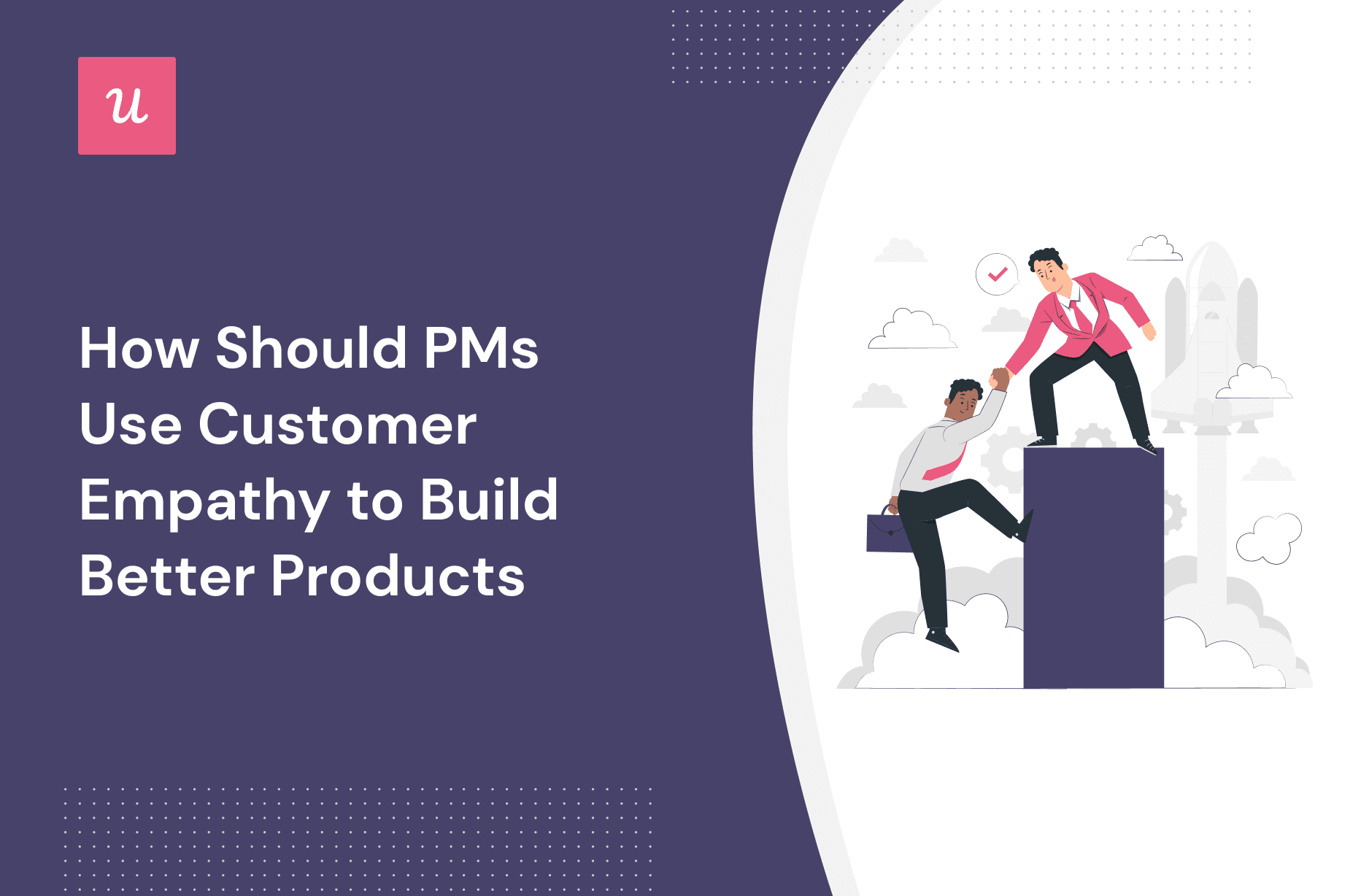
What do you need customer empathy for? How does it contribute to product success? How do you embed it into your product management processes?
If you’re after the answers to these questions, you’re in the right place, because that’s exactly what this article explores!
Are you ready to dive in?
Try Userpilot Now
See Why 1,000+ Teams Choose Userpilot

What is customer empathy?
Customer empathy means walking the same path your customers are taking.
It is the ability to look at the world from your users’ perspective and understand their pain points, needs, feelings, and emotions that drive their actions.
Customer empathy is more than empathetic customer service
If you run a quick Google search, empathetic customer service is the first thing that comes up.
There’s a bit of overlap between customer service empathy and customer empathy because both are essential to delivering a great customer experience.
However, this isn’t what we concentrate on in the article. Our focus is mainly on the product management process.
Why empathy skills are important for product managers
Product managers need customer empathy to understand their customers’ needs and pain points that need solving. This also means assessing how significant the problem is and whether it’s really worth solving for the customers.
Empathy is more important when it comes to developing solutions. To deliver a satisfying user experience, the solution needs to be practical to use and fit seamlessly into users’ lives.
Good empathy skills enable product managers to understand all the interdependencies and complexities and use the insights to create an empathetic approach to product development.
Best practices to put yourself in the customer’s shoes and develop customer empathy
Let’s look at a few basic techniques and methods that will force you to look at the product management process from your customer’s perspective.
Develop product personas
Product personas represent your real users, with all their problems, requirements, and needs.
The research that goes into building personas enables product managers to build an intimate knowledge of their target users.
Don’t focus on solely demographics and JTBDs though. Think about their feelings, motivations, daily struggles, and frustrations.
Make the user personas as realistic as possible. Add a name and a photo if this helps you develop a connection with them. This will not only help you to understand them better but increase your motivation to help them.

Work with customer empathy maps
Apart from templates, use empathy maps to help you develop your user personas and create a user experience that best addresses their practical and emotional needs.
What is a customer empathy map?
Essentially, it’s a visual representation of what the user says, thinks, does, and feels.
To create one, you divide your board into 4 sections, one of each of the 4 aspects. Next, collate all the information about the users you have, and assign it to the right category.

Build customer empathy with continuous discovery
The continuous discovery framework focuses on identifying user needs that are worth solving, developing solutions to address them, and using experimentation to determine how effective the solution is.
The key idea behind the process is that user needs constantly change. The problems that they faced yesterday may not be relevant anymore. They may have been replaced with new more pressing issues.
Discovering relevant user problems and keeping up with the changes requires constant interaction with your users.
To understand what customers feel, the product team and customer support agents need to empathize with users. And the more they do it, the more intimate the relationships become and they get better at delivering a human connection.

Make customer feedback a priority
Collecting user feedback, especially qualitative feedback, is one of the most straightforward ways of developing a better understanding of users’ needs and motivations.
To start with, collect feedback on the existing features to assess how well they satisfy user needs. This will help you identify ways to improve the features and deliver even better performance.

How to include the customer’s perspective and build better products with empathy
Building customer empathy is about practicing being empathetic and open to new ideas that emerge from user feedback and implementing them into the development process. How can you do it?
Switch to an inclusive product design process
Inclusive product design helps users of different backgrounds and with different needs to use the product’s full functionality and take advantage of its benefits.
Focusing on inclusive design forces team members to put themselves in the users’ position and look for different ways in which they could be excluded from using digital products.
What could be an example of inclusive product design?
Twitter recognizes that its users speak various languages and enables them to filter the content they see by language. If you’re not an English speaker, you can filter them out to unclutter your feed. Simple yet effective!

Identify friction and understand customer emotions behind it
Product friction could be anything that stops users from achieving their goals.
Identifying friction is the easiest way to find sources of frustration and confusion which could be costly to your business.
How can you find friction points?
Tracking product usage is an obvious method.
Once you find your friction points, reach out to your customers and try to understand what’s causing it.
Is it because it is overwhelming? Or maybe because it requires too much mental effort? Or perhaps it doesn’t work as expected?

Simplify and prioritize feedback collection
Talking of friction, make sure your feedback collection processes are as simple as possible. Otherwise, the response rates will be low and you won’t have information to make informed decisions.
For starters, trigger your surveys contextually, for example as soon as the user engages with a feature you’re testing. This way, the experience will still be fresh in their memory and they’re more likely to provide real value.

No matter how loyal they are, they won’t always be able to respond to the survey. That’s why apart from surveys, you should also collect passive feedback.
Simply add a widget to your resource center so that they can easily access it and share their thoughts and feelings whenever it works for them.

Understand what drives customer loyalty and stickiness
Product stickiness and customer loyalty drive long-term product success because they help you maximize revenue from existing customers.
If you can understand what motivates your users to keep renewing their subscriptions, you can leverage it to increase loyalty across your user base.
How do you do that?
First, use product growth data to segment your users. After that, approach users from the most loyal group and interview them.
A loyal customer will be happy to help. However, it does no harm to provide them with a bit of extra incentive like a voucher or discount code.

Collaborate with customer-facing teams
Your customer-facing colleagues like the customer service department, customer support, and sales teams have daily direct contact with your customers.
As a result, they may have lots of data that can help your efforts in understanding customers.
The insights that you get from your customer service rep or customer success manager will be invaluable when building user personas and empathy maps, so make sure to involve them in the process to find the right solution.
Validate new features before development
Developing new features is expensive and time-consuming. So before you commit to building anything, validate your ideas.
Some of the basic questions you need to answer in the process include:
- What is the user problem that it solves?
- How significant is the problem?
- Does your feature solve the problem?
- Are users willing to pay for the solution?
- Can you build it?
- Is it financially viable?
Prioritize features that solve pain points
When it comes to features, there are painkillers and vitamins.
While vitamins are nice to have and they can enhance the user experience, it’s the pain killers that users can’t live without. These are the features that solve actual problems.
These are the ones you should prioritize in the backlog. Focus on one feature at a time and iterate on them until they fully meet user needs and then move on to the next ones.
Using a framework like the Kano Model in customer discovery will help you identify which features to prioritize.

Aim for minimum delightful products
While painkillers are essential for product success, it doesn’t mean you should focus on them only.
First, such features may not be enough to keep your users engaged for a long time.
What’s more, a product based on basic functionality won’t be appealing to most users. That’s because apart from rational analysis, users rely heavily on emotions when making purchase decisions.
To evoke positive emotions, you need to add some vitamins that will fill the user’s interactions with your product with joy.
In other words, don’t rely on MVP to win over your customers, and aim for a Minimum Delightful Product instead.
Don’t forget about the customer experience
Building successful products is not only about delivering features that solve user problems. The overall customer experience matters a lot too.
To make your users stay with your company and keep using your product, try to provide them with Minimum Viable Experience (MVE).

To give the process some structure, use a customer journey map. Look at the user interactions at all touchpoints and focus on refining each of them.
For example, this could be removing unnecessary friction from the purchase process, using different interactive onboarding flows for different segments, and providing adequate support.
To further enhance these crucial mobile touchpoints, onboard and engage mobile app users by creating personalized messaging, push notifications, and surveys with Userpilot.
Conclusion
Customer empathy is about understanding what they need. It’s also about developing solutions that not only allow them to achieve their objectives but also evoke positive emotions.
If you would like to see how Userpilot can help you empathize with your customers by tracking their in-app behavior and streamlining feedback collection, book the demo!






